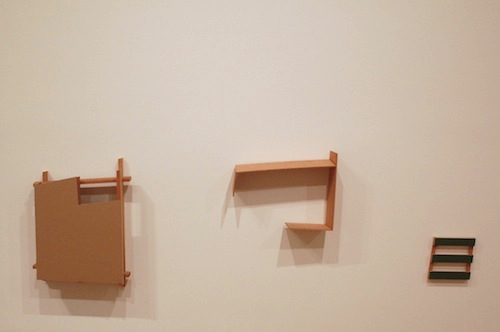
Unrelated, Elspeth Pratt, 2007
Elspeth Pratt's sculptures are simple. Mostly elegant quadrilaterals, they sit against the walls and on the floor of Reed's Cooley Gallery wide mouthed and hardy, in spite of their meager lines. They are instantly pleasing formally, drawing the viewer in with tactile conventions that are generous in their physical accessibility. These sculptures present their ideas quietly, allowing ample space for the viewer to exist in the suggestions of the artwork. Yet, there is something that seems deficient in this work. There is something in Pratt's oeuvre that feels as if it has been unfairly stopped short. Nonetheless is an exhibition that leaves the viewer uneasy and wanting, as the sculptures teeter on the edges of strange lines and blurry constructs.
Pratt's sculptures seem to be a bit at war with themselves. They are formal battles within ontological struggles. Replete with the reference of architecture and its absence, these shapes want to stand their own ground. They vie for an expressive subversion which they have not yet quite achieved and seem more like playful, three dimensional sketches for spatial subversion. In essence, they seem like buildings. And yet. . . They are buildings. And why shouldn't they be? Architecture as social signifier is an accurate, apropos, and even fierce language when its poetics employ and incite a discussion surrounding its consequences. It is a fluctuating force that in contemporary times is as changing a mirror of society as the internet and, when maintained, is one of the most honest historical documents in existence. Architecture is a social mirror in spite of itself, an integral beacon of priorities dated and fled. The greatest histories in the world would be lost without it. Pratt's choice of this vehicle to discuss her ideas is intriguing, especially as she places almost all of these pieces on the wall. The white of the wall (with the exception of Collateral Event, which is round, and Moveable Feast, which sits on the floor) acts as a void within which the eye naturally completes a sense of perspective: a contemporary cubist experience. Yet it is within the bodies of these buildings where their problems lie.
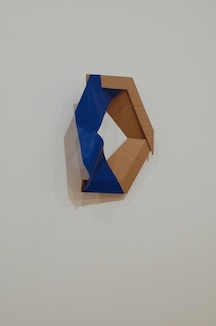
Collateral Event, Elspeth Pratt, 2007
While not every quadrilateral in the visual world is a building, Pratt’s sculptures in this exhibition exist as mostly architectural reference without staking any sort of symbolic claim. While the materials Pratt employs here are intentionally humble, as is the construction, she reaches for a language of metaphysics. This is possible yet difficult when the viewer is mired in the idea of building. This is not indicative of Pratt's entire yet is a quantifier for this exhibition. In her lecture, Pratt mentioned the idea of spatial reference as a symbol one can recognize yet cannot name. This idea is fantastic, and the space where these shapes exists is strange and science fiction like. Eva Hesse, Richard Tuttle, Elsworth Kelly, Mary Heilman, Jonathan Lasker, and Ivin Ballen are artists that do this.
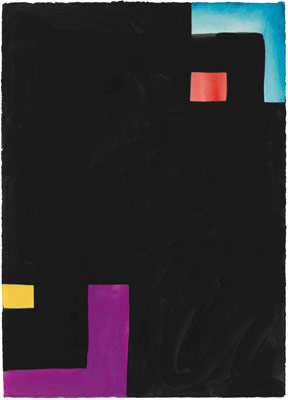
Garden of Allah #2, 1994, Mary Heilmann
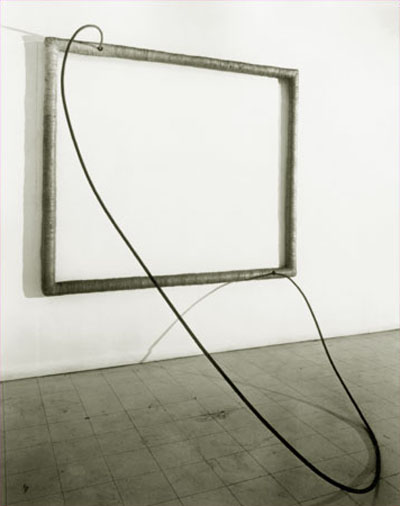
Hang Up, 1966, Eva Hesse
Theirs is language discovered, explored, and pushed. However, Pratt's work is still too architectural to be without name, and almost too architectural to be imbued with symbol. They seem reminiscent of a zeitgeist: iconic and from an era of post minimalism and fearful non commitment. The language of this work is incredibly formal, yet there is something dishonest here as the work fumbles beneath a misnomer. These sculptures seem more like an architect's haphazard models for somewhat subversive architecture than an artist's nod to architecture in the midst of reifying her ideas. I cannot be sure why the artist chooses to do this for this exhibition. To claim its own uncertain, formal experimentation would seem to be a much more interesting experience for this work, yet perhaps the contemporary age of rhetoric does not always allow artists to do this. . .The sculptures of Nonetheless seem to falter beneath some sort of embraced limit, perhaps brought on by language. Material alone cannot comprise the entirety of language, and an alphabet is not a book of poetry. Working within a minimal construction renders the voice of a material crisper and louder, and Pratt has neglected this among these pieces in a way that becomes increasingly apparent the longer you sit with them.
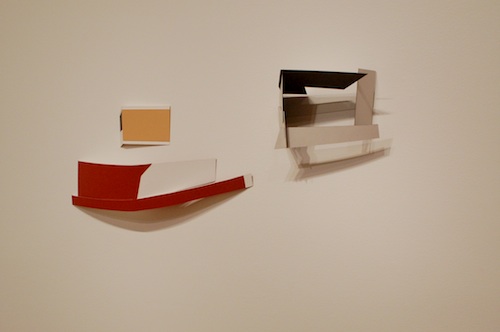
Facing Out, Elspeth Pratt, 2008
Pratt's pieces in Nonetheless are eloquent aberrations that achieve more buzz than hum. Their materials, while fraught with subtle and benign suggestion, are not slapped or heralded or disappointed enough to do more than stand. They exist within a construction of ideals that is only nascent, asking their creator for more honest consideration and more time.
























